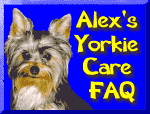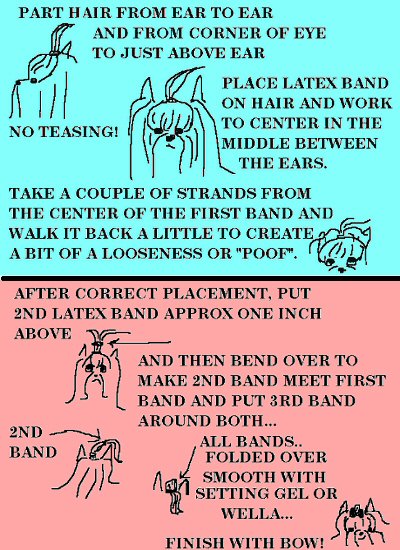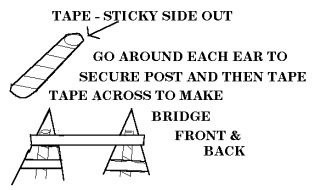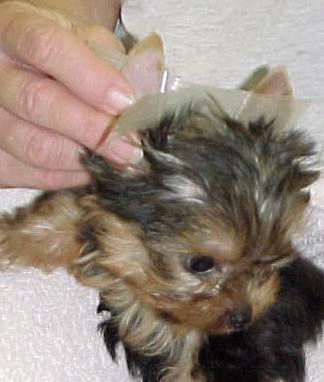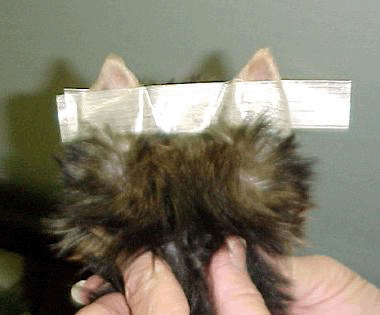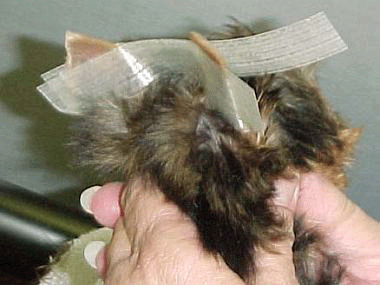Excerpts taken, with permission, from several other quality Web Sites
WASHING:
Yorkies have a wash and wear coat. They are a single coated dog and should be washed every 7-10 days. Use a good quality Pet shampoo like Pet Silk, or my preference, EQYSS Premier Color Intensifying Shampoo.
Human shampoo products have a different Ph balance and should be avoided.
I also recommend using a cream rinse to make blow drying the coat easier and to give more manageability to the coat.
You should keep the ears, the hair on their feet and around the rectum trimmed, and keep their nails short. Whenever you start grooming your dog, be sure the dog has good footing, both in the grooming area and in the sink. Drydek or a bath mat will do. It's also very comforting to have warm towels from the dryer to wrap your wet dog in after bathing.
Brushing the dog should be done daily to keep the coat from getting matted. If the dog is severely matted, then you may want to work in a good "detangler" like "Showsheen ot The Stuff". I use EQYSS Products, Cloud Nine Coat Conditioning Cream Rinse and Detangler. URL for EQYSS: http://www.eqyss.com
Some Yorkies have what's referred to as a COTTONY coat. This is a very fine textured coat and it presents additional grooming challenges as it matts very easily. A good product to control this is Showsheen Hair Polish. This is an equine product but works great for this type of coat. ( http://www.absorbine-animal.com )
Gettin' Ready For Bathtime in our new bathrobes!
This page was last updated on: September 10, 2018
Something about Collapsed Trachea and Reverse Sneezing
The trachea, also known as the windpipe, is an important structure which connects the throat to the lungs. It is composed of 35- 45 C-shaped rings of cartilage that are joined by muscle and ligaments to create a tube-like structure. It serves the purpose of directing air into the respiratory tract.
When the cartilage rings are flattened from the top to the bottom, the trachea is said to be collapsed. Rapid inhalation of air can cause the trachea to flatten and make it difficult for air to enter the lungs, much like a soda straw being drawn on too vigorously.
Why does it happen?
We do not completely understand how this condition develops. However, we know that these dogs have an abnormality in the chemical makeup of their tracheal rings. The rings lose their stiffness so they are not able to retain their circular shape. We also know that it occurs in certain breeds of dogs, notably Chihuahuas, Pomeranians, Shih Tzus, Lhasa Apsos, Toy Poodles, and Yorkshire Terriers. Because of that, it is suspected that there is a genetic factor involved.
What are the signs?
Collapsing trachea or Reverse sneezing
With reverse sneezing the pharynx (back of the throat) goes into spasms. The dog finds it difficult to draw in air through the spasms, so it stands still, stretches out her neck, and thrusts its elbows out (like a bowlegged bulldog) as it honks, wheezes, or snorts. Often eyes open wide. The spasms will stop if she swallows a couple of times.
Close off her nostrils with your fingers so it has to breathe through its mouth for a few seconds. Gently rub its throat. This works for some. Distract it by carrying the dog outside into the fresh air.
Young puppies can reverse sneeze, but the first episode typically occurs in late adolescence. Stay calm and get it to swallow with one of the methods described above. In a few seconds to a minute, it will run off to play. Reverse sneezing is a harmless phenomenon which needs no vet consultation and no medical treatment whatsoever. It is very common in toy breeds.
Other signs, however, will help you distinguish the two conditions: If it makes these sounds when excited or after eating or drinking, or turns her elbows outward and extends its neck and gasps inward with a rhythmic snork! snork! snork!, this is reverse sneezing. If it breathes through the mouth sometimes, or breathes with a raspy sound, or coughs reflexively when you simply rub its throat, it could have a collapsing trachea. If the cough is one or two expulsive outward bursts (forcing air through the trachea to open it), typically with a gag or empty retch at the end, she could have a collapsing trachea.
The most common clinical sign of collapsing trachea is a chronic cough. It is often described as dry and harsh and can become quite pronounced. The term "goose honk" is often used to describe it. Coughing is often worse in the daytime and much less at night. The cough may also begin due to excitement, pressure on the trachea (from a leash), or from drinking water or eating.
If you suspect collapsed trachea or are confused as to the difference between the two, contact your vet ASAP
Hypoglycemia
If your new puppy is lethargic or comatose it may be caused by HYPOGLYCEMIA. This can be a life threatening condition brought on by the stress of its new environment and the resulting lack of nutrition. It usually occurs in puppies from 4 to 5 months old but older toy dogs can also get it.
New puppies can also be stressed by lack of sleep and over-handling. They may refuse to eat because their food has changed or they don't know where the food is. Changes in the ambient temperature of the room that they are used to can also be the cause of stress.
A lifeless or limp lethargic puppy with grayish-blue gums and tongue is another indication of Hypoglycemia. A sub-normal temperature, with the puppy seeming to shiver and shake requires immediate attention. If left untreated the puppy may go into a coma with resulting convulsions and death could be the tragic result if treatment is withheld.
Low blood sugar is the cause and the blood glucose level must be raised at once. Care from a Vet is the best choice but don't wait; every second counts. Mix Corn Syrup (Karo) or plain Sugar with equal proportion of water and, using a syringe, feed the pup 10cc orally four times a day.
Hypoglycemia, treated in time, should leave no lasting affects and as long as the stress is eliminated it shouldn't occur again.
Do I have to brush my Yorkie's teeth?
Some dogs teeth form placque faster than others...and yes you should brush at least once a week with Nolvadent (from your vet or supply house) and put a drop of glyoxide (from your pharmacy) on either side of the mouth in back once a week. You should also get a dental scraper and learn how to scrape the teeth....
Omaha Vet 1-800-367-4444 has dental scrapers and you should try to scrape the teeth every other month. If you don't keep the teeth clean, they will develop periodontal disease. Bacteria buildup on the teeth can also lead to Heart problems.
Once in a while you'll need professional dental cleaning done by your vet. This requires intubating the dog under anesthetic. The current practice is to give a small dose of Valium & Ketamine and once the dog is relaxed, inserting a tube down the throat and administering Isoflorane or Sevoflorane Gas. Then the cleaning process can proceed. Some vets also will give a prescription for an antibiotic to be given after the cleaning. This is done as a preventative for any type of bacterial infection.
How to Do A Topknot
Above & Below Published with Permission from Terri Shumsky
If you are taping the ears on a litter of pups, please do separate those pups before you do any taping. This is very important anyway as pups can "bully" each other and those little needle teeth can be very painful. Separating your pups at 7 weeks with a divider gives them a chance to develop their own personality plus it encourages them to start "bonding" with humans rather than become a "pack animal."
It's perfectly normal for the ears to droop during teething. However, the thickness of the ears is in the breeding and if they are too thick, they may not come up. The ears should be trimmed on the edge about halfway down each side, then use a clipper (the Wahl clipper is available in your local Payless or other drug store, the kind that is used to trim the hair on the back of the neck) with a surgical blade, about halfway down front and back of each ear. This is usually started at about four weeks but if your puppy's ears are still not up, you must take off the hair, massage them regularly, say once a day, to keep the circulation going and tape them as shown.
A dental absorber is a good post...wrap some aerated Johnson & Johnson tape backwards so the sticky side is out and insert on the base of the ear as support and wrap more aerated tape as shown.
Then tape a bridge between the ears with 3/4" 3M filament tape to hold them up, being careful they are in a natural position.
You can keep the ears taped for a week, but then even if they haven't come loose, you must remove them and make sure the pups ears are dry and clean. Whether they are up or not, leave them alone for a day or two. Retape them if they fall again.
Smell the ear and if there is an odor, you may want to ask your veterinarian for some Tresaderm. An odor could mean an ear infection and if the ear is odorous or looks swollen, don't re-tape until you've corrected the situation or seen a Vet.
Taping the Ears
Dangerous Food For Dogs Note: NOT A COMPLETE LIST
Chocolate:
Chocolate contains methylxanthine alkaloids in the form of theobromine and caffeine, that cause constriction of arteries, increased heart rate, and central nervous system stimulation. These effects can lead to vomiting, diarrhea, restlessness, and increased urinations. More advanced symptoms of toxicity include excitability, increased respirations and heartbeat, stiffness, seizures and exaggerated reflexes.
Certain types of chocolate contain higher amounts of methylxanthines, baking chocolate containing the highest and white chocolate containing the least. Dogs freely ingest toxic amounts of chocolate if it is left accessible. A potentially lethal dose in a 16 pound. dog is only one pound of milk chocolate and only about 2 oz of bakers chocolate.
Cardiac failure, seizures, coma, and death can result if the chocolate ingestion is not found within four to six hours and treated appropriately. The length of action of the methylxanthines is usually 12 to 36 hours. In dogs that chocolate ingestion is detected early, the prognosis is good.
Grapes and Raisins:
Apparently, grapes and raisins can be toxic to dogs when ingested in large quantities. The grapes and raisins came from varied sources, including being eaten off the vine directly. The dogs exhibited gastrointestinal signs including vomiting and diarrhea and then signs of kidney failure with an onset of severe kidney signs starting about 24 hours after ingestion of the grapes or raisins. The amount of grapes eaten varied between 9oz. and 2 lbs., which worked out to be between 0.41 and 1.1 oz/kg of body weight. Two dogs died directly from the toxicity, three were euthanized due to poor response to treatment and five dogs lived. Due to the severity of the signs and the potential for death, the veterinarians as the poison control center advocate aggressive treatment for any dogs suggested of ingesting excessive amounts of grapes or raisins, including inducing vomiting, stomach lavage (stomach pumping) and administration of activated charcoal, followed by intravenous fluid therapy for at least 48 hours or as indicated based on the results of blood tests for kidney damage.
Turkey:
While white turkey meat, properly cooked and in reasonable quantities doesn't pose a danger to most dogs but turkey skin can be extremely harmful to your dog. The high fat content of turkey skin and dark turkey meat is known to cause pancreatitis leading to death if not properly treated in a timely manner. Pancreatitis is extremely painful to a dog. The protocol for treatment of Pancreatitis consists of withdrawal of all food for a period of up to three days while IV hydration is implemented to keep the dog from getting dehydrated while resting the pancreas.
Nuts:
Walnuts are poisonous to dogs and should be avoided. In particular, there is a type of fungus common to walnuts (especially wet deadfall walnuts) that will cause severe episodes of seizuring. Many nuts are not good for dogs in general, their high phosphorous content is said to possibly lead to bladder stones.
Macadamia nuts are another concern. The toxic compound is unknown but the affect of macadamia nuts is to cause locomotory difficulties. Dogs develop a tremor of the skeletal muscles, and weakness or paralysis of the hindquarters. Affected dogs are often unable to rise and are distressed, usually panting. Some affected dogs have swollen limbs and show pain when the limbs are manipulated.
Dogs have been affected by eating as few as six macadamia kernels (nuts without the shell) while others had eaten approximately forty kernels. Some dogs had also been given macadamia butter.
Luckily, the muscle weakness, while painful, seems to be of short duration and all dogs recovered from the toxicity. All dogs were taken to their veterinary surgeon.
Onions:
Onions, and to a lesser degree garlic, are other dangerous food ingredients that cause sickness in dogs, cats and also livestock. Onions and garlic contain the toxic ingredient thiosulphate. Onions are more of a danger.
Pets affected by onion toxicity will develop haemolytic anaemia, where the pet’s red blood cells burst while circulating in its body.
Sugarless Candy:
Sugarless candies can be toxic to pets. Candies containing xylitol have been recognized by the National Animal Poison Control Center to be a risk to pets. This information was first published in July 2004. This compound can cause liver damage and death in dogs susceptible to being poisoned with xylitol. If your dog ingests sugarless candy it would be best to contact the NAPCC (1-888-426-4435). It is possible your vet will not be familiar with this source of poisoning as this information is fairly new and candies have not usually been associated with poisonings in dogs if they did not contain chocolate as the major ingredient.
Antifreeze:
Although not a food antifreeze can pose an eminent danger to a dog or cat. The most commonly used antifreeze compounds contain ethylene glycol, which is toxic to dogs and cats if ingested. The minimal lethal dosage for cats is 1.4ml/kg of body weight and for dogs 4.4 to 6.6 ml/kg of undiluted ethylene glycol.
This means that 1 teaspoonful of antifreeze (5ml) could kill a 7 pound cat. Antifreeze is normally diluted for use in automobiles so more of the diluted solution would have to be ingested to achieve toxic levels. Unfortunately, antifreeze seems to be palatable to dogs and cats and ingestion of large amounts of the solution can occur.
There are other foods, plants, cleaning products and various other compounds that can be harmful to your dog. The Internet provides a tremendous resource to search for these items that can be fatal to your beloved pet.
When in doubt, contact your Veterinarian or local Poison Control Center............
Yorkie Care
Website Designed by Stephen Glass © 2018
